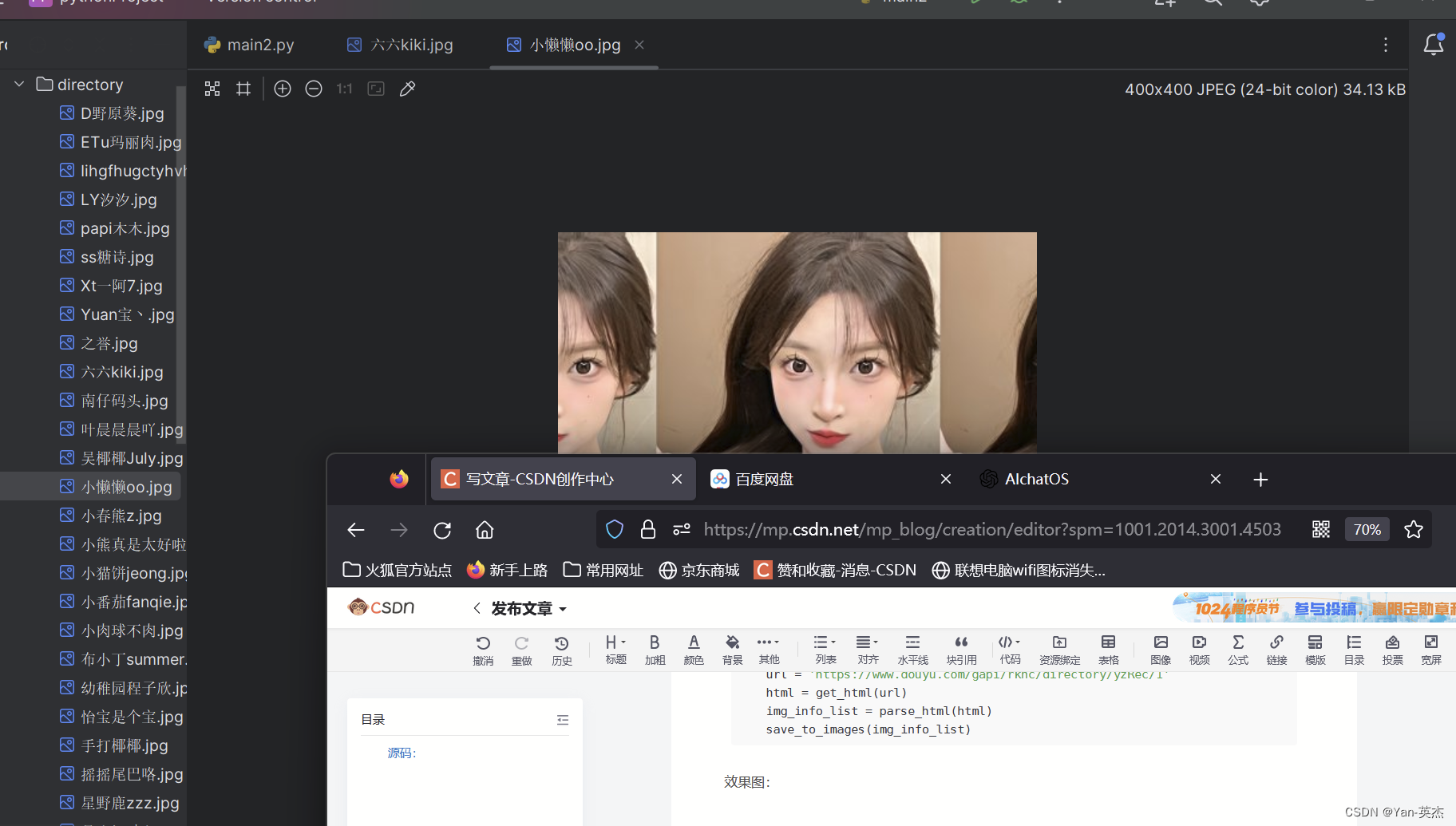大家好,我是博主英杰,整理了几个常见的爬虫案例,分享给大家,适合小白学习
欢迎来到英杰社区![]() https://bbs.csdn.net/topics/617804998
https://bbs.csdn.net/topics/617804998
一、爬取豆瓣电影排行榜Top250存储到Excel文件
近年来,Python在数据爬取和处理方面的应用越来越广泛。本文将介绍一个基于Python的爬虫程序,用于抓取豆瓣电影Top250的相关信息,并将其保存为Excel文件。
获取网页数据的函数,包括以下步骤:
1. 循环10次,依次爬取不同页面的信息;
2. 使用`urllib`获取html页面;
3. 使用`BeautifulSoup`解析页面;
4. 遍历每个div标签,即每一部电影;
5. 对每个电影信息进行匹配,使用正则表达式提取需要的信息并保存到一个列表中;
6. 将每个电影信息的列表保存到总列表中。
效果展示:
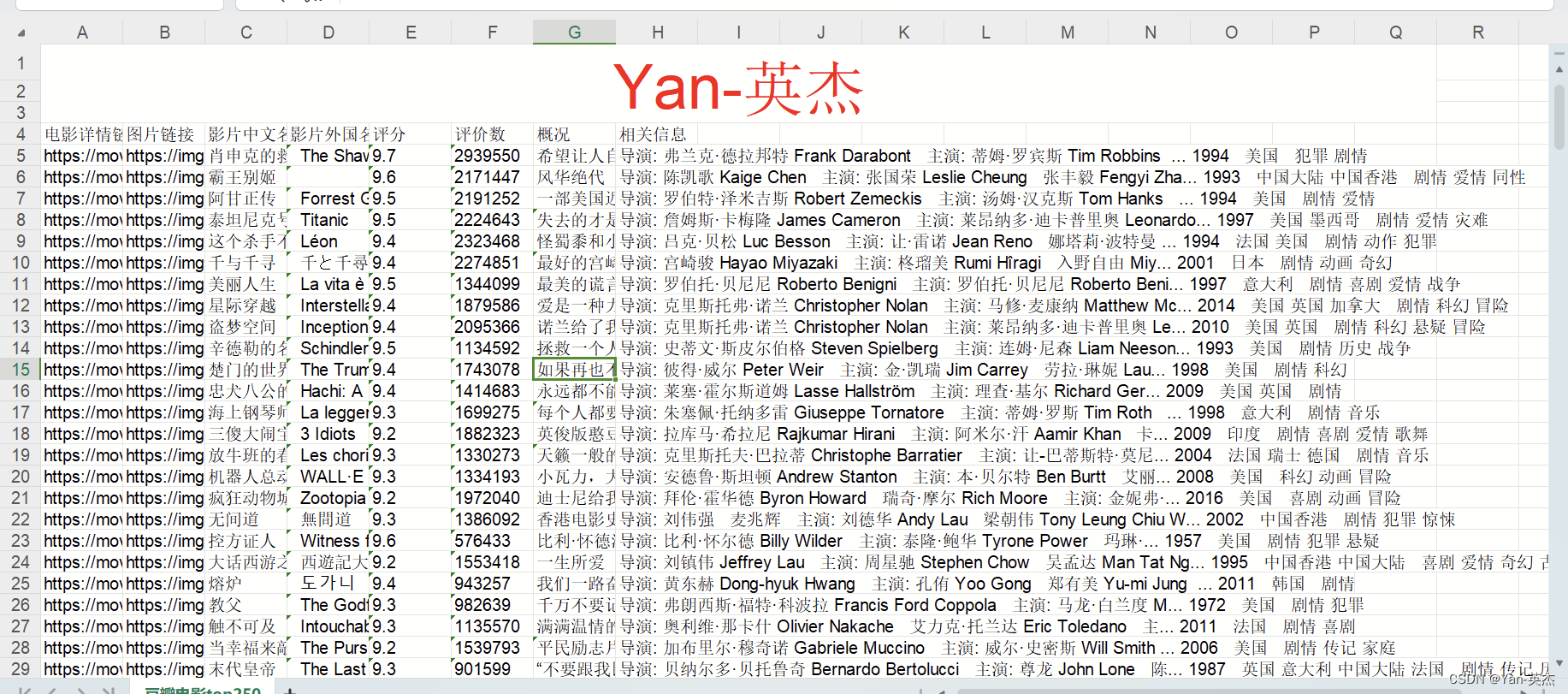
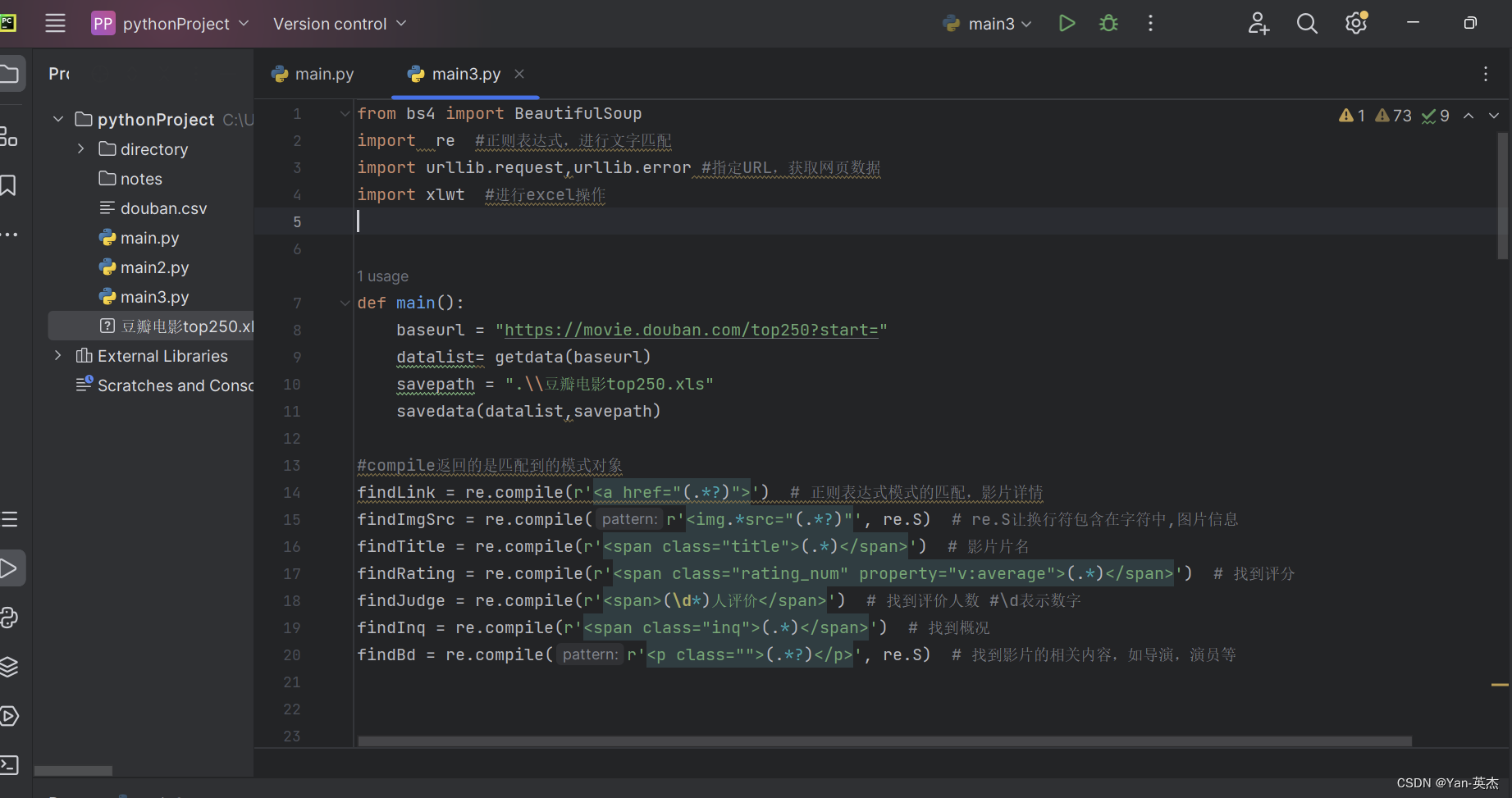
源代码:
from bs4 import BeautifulSoup import re #正则表达式,进行文字匹配 import urllib.request,urllib.error #指定URL,获取网页数据 import xlwt #进行excel操作 def main(): baseurl = "https://movie.douban.com/top250?start=" datalist= getdata(baseurl) savepath = ".\\豆瓣电影top250.xls" savedata(datalist,savepath) #compile返回的是匹配到的模式对象 findLink = re.compile(r'<a href="(.*?)">') # 正则表达式模式的匹配,影片详情 findImgSrc = re.compile(r'<img.*src="(.*?)"', re.S) # re.S让换行符包含在字符中,图片信息 findTitle = re.compile(r'<span class="title">(.*)</span>') # 影片片名 findRating = re.compile(r'<span class="rating_num" property="v:average">(.*)</span>') # 找到评分 findJudge = re.compile(r'<span>(\d*)人评价</span>') # 找到评价人数 #\d表示数字 findInq = re.compile(r'<span class="inq">(.*)</span>') # 找到概况 findBd = re.compile(r'<p class="">(.*?)</p>', re.S) # 找到影片的相关内容,如导演,演员等 ##获取网页数据 def getdata(baseurl): datalist=[] for i in range(0,10): url = baseurl+str(i*25) ##豆瓣页面上一共有十页信息,一页爬取完成后继续下一页 html = geturl(url) soup = BeautifulSoup(html,"html.parser") #构建了一个BeautifulSoup类型的对象soup,是解析html的 for item in soup.find_all("div",class_='item'): ##find_all返回的是一个列表 data=[] #保存HTML中一部电影的所有信息 item = str(item) ##需要先转换为字符串findall才能进行搜索 link = re.findall(findLink,item)[0] ##findall返回的是列表,索引只将值赋值 data.append(link) imgSrc = re.findall(findImgSrc, item)[0] data.append(imgSrc) titles=re.findall(findTitle,item) ##有的影片只有一个中文名,有的有中文和英文 if(len(titles)==2): onetitle = titles[0] data.append(onetitle) twotitle = titles[1].replace("/","")#去掉无关的符号 data.append(twotitle) else: data.append(titles) data.append(" ") ##将下一个值空出来 rating = re.findall(findRating, item)[0] # 添加评分 data.append(rating) judgeNum = re.findall(findJudge, item)[0] # 添加评价人数 data.append(judgeNum) inq = re.findall(findInq, item) # 添加概述 if len(inq) != 0: inq = inq[0].replace("。", "") data.append(inq) else: data.append(" ") bd = re.findall(findBd, item)[0] bd = re.sub('<br(\s+)?/>(\s+)?', " ", bd) bd = re.sub('/', " ", bd) data.append(bd.strip()) # 去掉前后的空格 datalist.append(data) return datalist ##保存数据 def savedata(datalist,savepath): workbook = xlwt.Workbook(encoding="utf-8",style_compression=0) ##style_compression=0不压缩 worksheet = workbook.add_sheet("豆瓣电影top250",cell_overwrite_ok=True) #cell_overwrite_ok=True再次写入数据覆盖 column = ("电影详情链接", "图片链接", "影片中文名", "影片外国名", "评分", "评价数", "概况", "相关信息") ##execl项目栏 for i in range(0,8): worksheet.write(0,i,column[i]) #将column[i]的内容保存在第0行,第i列 for i in range(0,250): data = datalist[i] for j in range(0,8): worksheet.write(i+1,j,data[j]) workbook.save(savepath) ##爬取网页 def geturl(url): head = { "User-Agent": "Mozilla/5.0 (Windows NT 10.0; Win64; x64) " "AppleWebKit/537.36 (KHTML, like Gecko) Chrome/86.0.4240.111 Safari/537.36" } req = urllib.request.Request(url,headers=head) try: ##异常检测 response = urllib.request.urlopen(req) html = response.read().decode("utf-8") except urllib.error.URLError as e: if hasattr(e,"code"): ##如果错误中有这个属性的话 print(e.code) if hasattr(e,"reason"): print(e.reason) return html if __name__ == '__main__': main() print("爬取成功!!!")二、爬取百度热搜排行榜Top50+可视化
2.1 代码思路:
-
导入所需的库:
import requests from bs4 import BeautifulSoup import openpyxl
requests库用于发送HTTP请求获取网页内容。
BeautifulSoup库用于解析HTML页面的内容。
openpyxl库用于创建和操作Excel文件。
2.发起HTTP请求获取百度热搜页面内容:
url = 'https://top.baidu.com/board?tab=realtime' response = requests.get(url) html = response.content这里使用了
requests.get()方法发送GET请求,并将响应的内容赋值给变量html。
3.使用BeautifulSoup解析页面内容:
soup = BeautifulSoup(html, 'html.parser')
创建一个
BeautifulSoup对象,并传入要解析的HTML内容和解析器类型。
4.提取热搜数据:
hot_searches = [] for item in soup.find_all('div', {'class': 'c-single-text-ellipsis'}): hot_searches.append(item.text)这段代码通过调用
soup.find_all()方法找到所有<div>标签,并且指定class属性为'c-single-text-ellipsis'的元素。然后,将每个元素的文本内容添加到
hot_searches列表中。
5.保存热搜数据到Excel:
workbook = openpyxl.Workbook() sheet = workbook.active sheet.title = 'Baidu Hot Searches'使用
openpyxl.Workbook()创建一个新的工作簿对象。调用
active属性获取当前活动的工作表对象,并将其赋值给变量sheet。使用
title属性给工作表命名为'Baidu Hot Searches'。
6.设置标题:
sheet.cell(row=1, column=1, value='百度热搜排行榜—博主:Yan-英杰')使用
cell()方法选择要操作的单元格,其中row和column参数分别表示行和列的索引。将标题字符串
'百度热搜排行榜—博主:Yan-英杰'写入选定的单元格。
7.写入热搜数据:
for i in range(len(hot_searches)): sheet.cell(row=i+2, column=1, value=hot_searches[i])使用
range()函数生成一个包含索引的范围,循环遍历hot_searches列表。对于每个索引
i,使用cell()方法将对应的热搜词写入Excel文件中。
8.保存Excel文件:
workbook.save('百度热搜.xlsx')使用
save()方法将工作簿保存到指定的文件名'百度热搜.xlsx'。
9.输出提示信息:
print('热搜数据已保存到 百度热搜.xlsx')在控制台输出保存成功的提示信息。
效果展示:
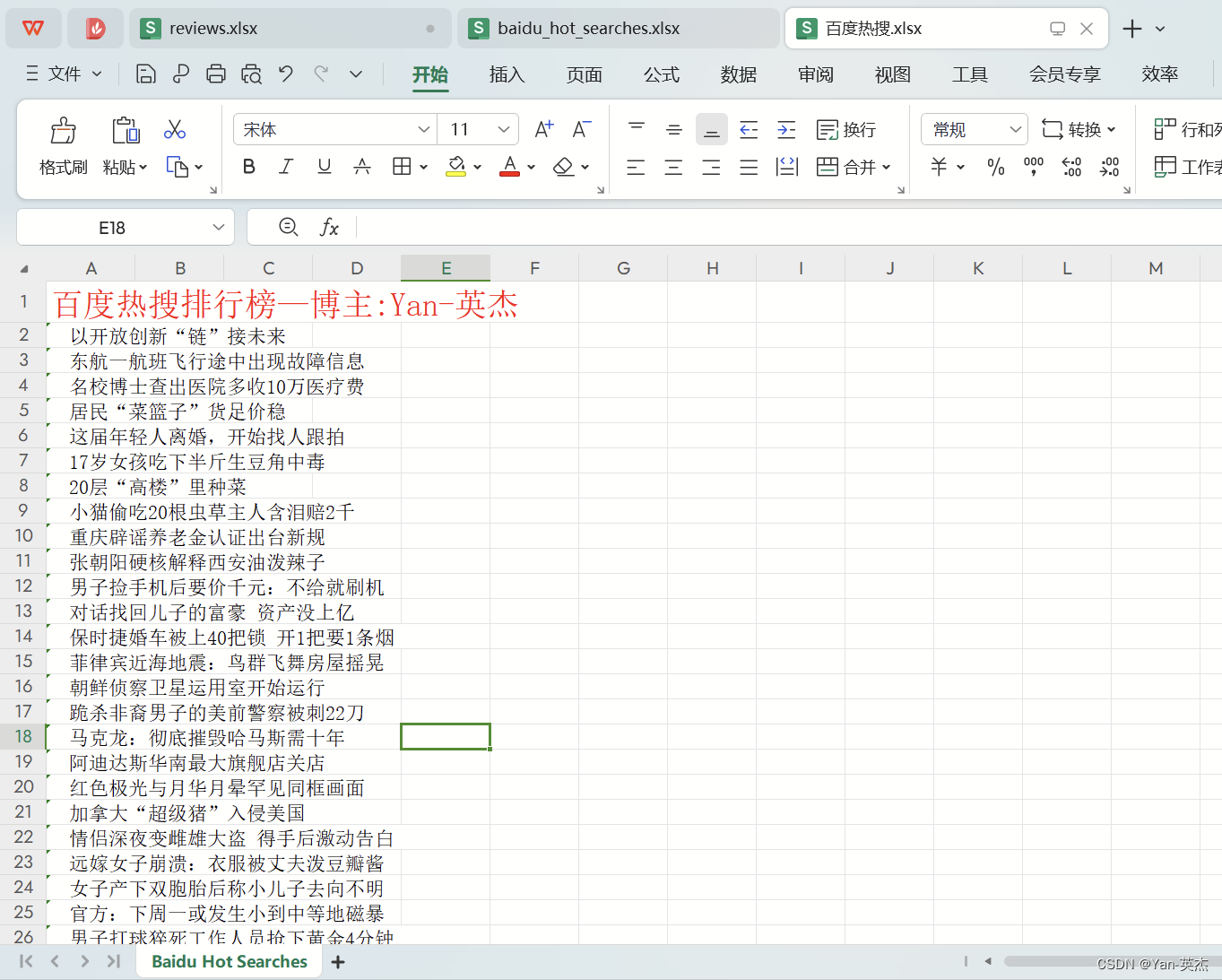
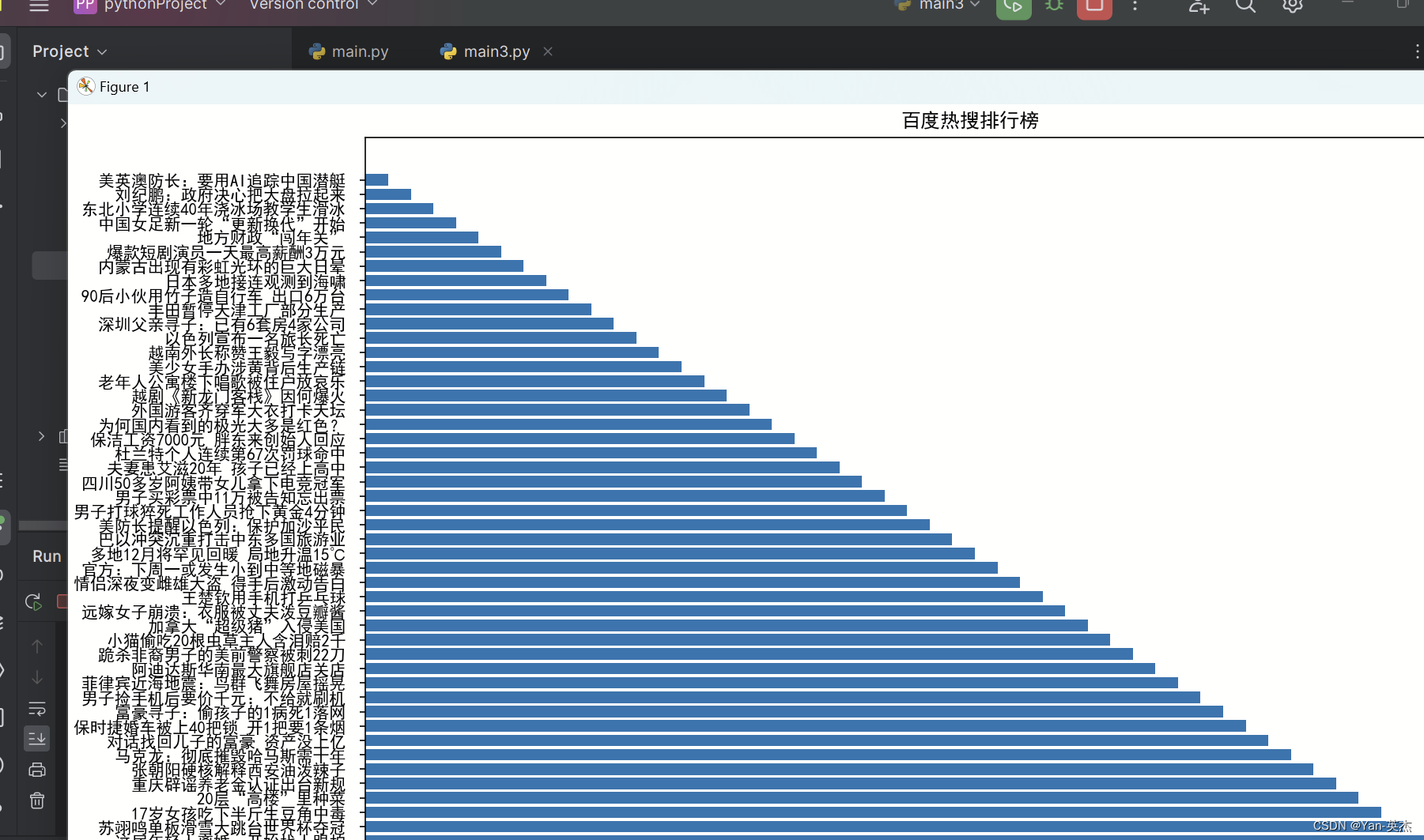
源代码:
import requests from bs4 import BeautifulSoup import openpyxl # 发起HTTP请求获取百度热搜页面内容 url = 'https://top.baidu.com/board?tab=realtime' response = requests.get(url) html = response.content # 使用BeautifulSoup解析页面内容 soup = BeautifulSoup(html, 'html.parser') # 提取热搜数据 hot_searches = [] for item in soup.find_all('div', {'class': 'c-single-text-ellipsis'}): hot_searches.append(item.text) # 保存热搜数据到Excel workbook = openpyxl.Workbook() sheet = workbook.active sheet.title = 'Baidu Hot Searches' # 设置标题 sheet.cell(row=1, column=1, value='百度热搜排行榜—博主:Yan-英杰') # 写入热搜数据 for i in range(len(hot_searches)): sheet.cell(row=i+2, column=1, value=hot_searches[i]) workbook.save('百度热搜.xlsx') print('热搜数据已保存到 百度热搜.xlsx')可视化代码:
import requests from bs4 import BeautifulSoup import matplotlib.pyplot as plt # 发起HTTP请求获取百度热搜页面内容 url = 'https://top.baidu.com/board?tab=realtime' response = requests.get(url) html = response.content # 使用BeautifulSoup解析页面内容 soup = BeautifulSoup(html, 'html.parser') # 提取热搜数据 hot_searches = [] for item in soup.find_all('div', {'class': 'c-single-text-ellipsis'}): hot_searches.append(item.text) # 设置中文字体 plt.rcParams['font.sans-serif'] = ['SimHei'] plt.rcParams['axes.unicode_minus'] = False # 绘制条形图 plt.figure(figsize=(15, 10)) x = range(len(hot_searches)) y = list(reversed(range(1, len(hot_searches)+1))) plt.barh(x, y, tick_label=hot_searches, height=0.8) # 调整条形图的高度 # 添加标题和标签 plt.title('百度热搜排行榜') plt.xlabel('排名') plt.ylabel('关键词') # 调整坐标轴刻度 plt.xticks(range(1, len(hot_searches)+1)) # 调整条形图之间的间隔 plt.subplots_adjust(hspace=0.8, wspace=0.5) # 显示图形 plt.tight_layout() plt.show()三、爬取斗鱼直播照片保存到本地目录
效果展示:

源代码:
#导入了必要的模块requests和os import requests import os # 定义了一个函数get_html(url), # 用于发送GET请求获取指定URL的响应数据。函数中设置了请求头部信息, # 以模拟浏览器的请求。函数返回响应数据的JSON格式内容 def get_html(url): header = { 'user-agent': 'Mozilla/5.0 (Windows NT 10.0; Win64; x64) AppleWebKit/537.36 (KHTML, like Gecko) Chrome/74.0.3729.169 Safari/537.36' } response = requests.get(url=url, headers=header) # print(response.json()) html = response.json() return html # 定义了一个函数parse_html(html), # 用于解析响应数据中的图片信息。通过分析响应数据的结构, # 提取出每个图片的URL和标题,并将其存储在一个字典中,然后将所有字典组成的列表返回 def parse_html(html): rl_list = html['data']['rl'] # print(rl_list) img_info_list = [] for rl in rl_list: img_info = {} img_info['img_url'] = rl['rs1'] img_info['title'] = rl['nn'] # print(img_url) # exit() img_info_list.append(img_info) # print(img_info_list) return img_info_list # 定义了一个函数save_to_images(img_info_list),用于保存图片到本地。 # 首先创建一个目录"directory",如果目录不存在的话。然后遍历图片信息列表, # 依次下载每个图片并保存到目录中,图片的文件名为标题加上".jpg"后缀。 def save_to_images(img_info_list): dir_path = 'directory' if not os.path.exists(dir_path): os.makedirs(dir_path) for img_info in img_info_list: img_path = os.path.join(dir_path, img_info['title'] + '.jpg') res = requests.get(img_info['img_url']) res_img = res.content with open(img_path, 'wb') as f: f.write(res_img) # exit() #在主程序中,设置了要爬取的URL,并调用前面定义的函数来执行爬取、解析和保存操作。 if __name__ == '__main__': url = 'https://www.douyu.com/gapi/rknc/directory/yzRec/1' html = get_html(url) img_info_list = parse_html(html) save_to_images(img_info_list)四、爬取酷狗音乐Top500排行榜
从酷狗音乐排行榜中提取歌曲的排名、歌名、歌手和时长等信息
代码思路: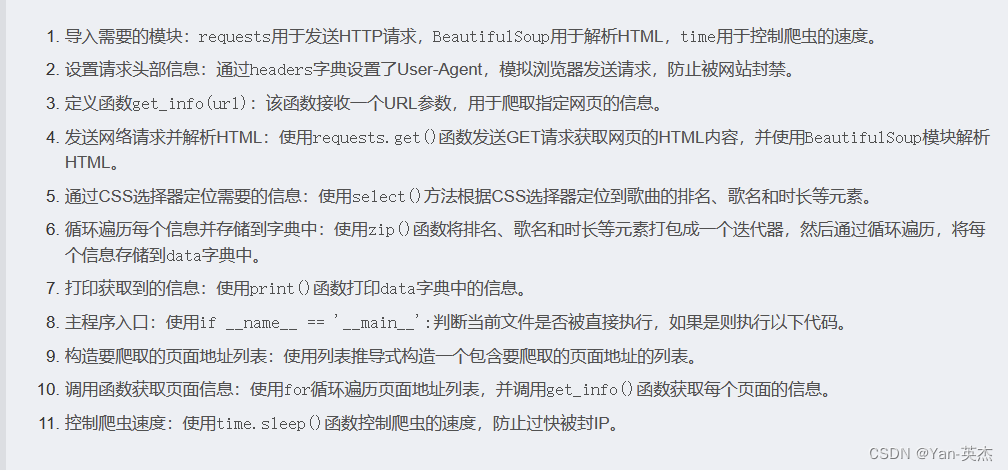
效果展示:
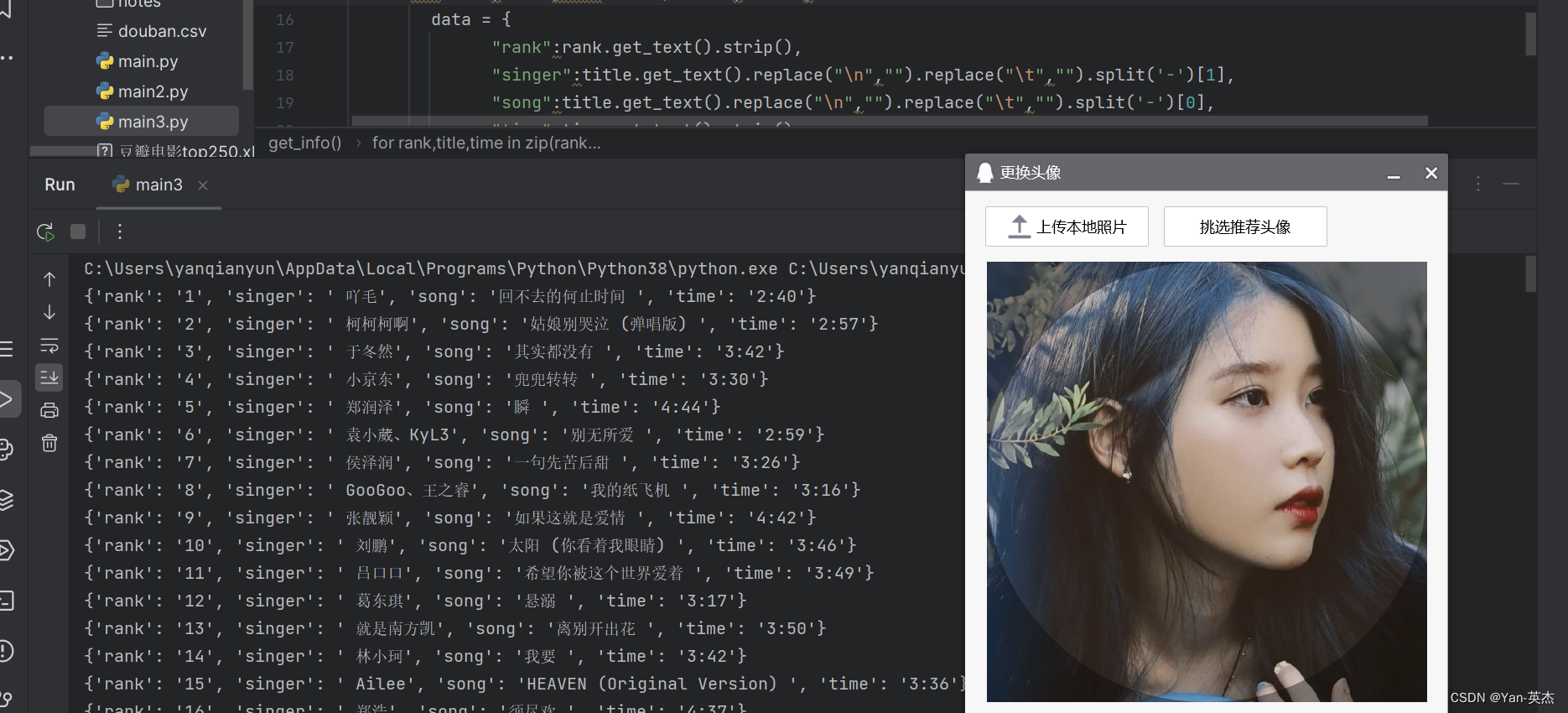
源码:
import requests # 发送网络请求,获取 HTML 等信息 from bs4 import BeautifulSoup # 解析 HTML 信息,提取需要的信息 import time # 控制爬虫速度,防止过快被封IP headers = { "User-Agent": "Mozilla/5.0 (Windows NT 10.0; Win64; x64) AppleWebKit/537.36 (KHTML, like Gecko) Chrome/97.0.4692.71 Safari/537.36" # 添加浏览器头部信息,模拟请求 } def get_info(url): # 参数 url :要爬取的网页地址 web_data = requests.get(url, headers=headers) # 发送网络请求,获取 HTML 等信息 soup = BeautifulSoup(web_data.text, 'lxml') # 解析 HTML 信息,提取需要的信息 # 通过 CSS 选择器定位到需要的信息 ranks = soup.select('span.pc_temp_num') titles = soup.select('div.pc_temp_songlist > ul > li > a') times = soup.select('span.pc_temp_tips_r > span') # for 循环遍历每个信息,并将其存储到字典中 for rank, title, time in zip(ranks, titles, times): data = { "rank": rank.get_text().strip(), # 歌曲排名 "singer": title.get_text().replace("\n", "").replace("\t", "").split('-')[1], # 歌手名 "song": title.get_text().replace("\n", "").replace("\t", "").split('-')[0], # 歌曲名 "time": time.get_text().strip() # 歌曲时长 } print(data) # 打印获取到的信息 if __name__ == '__main__': urls = ["https://www.kugou.com/yy/rank/home/{}-8888.html".format(str(i)) for i in range(1, 24)] # 构造要爬取的页面地址列表 for url in urls: get_info(url) # 调用函数,获取页面信息 time.sleep(1) # 控制爬虫速度,防止过快被封IP五、爬取链家二手房数据做数据分析
在数据分析和挖掘领域中,网络爬虫是一种常见的工具,用于从网页上收集数据。介绍如何使用 Python 编写简单的网络爬虫程序,从链家网上海二手房页面获取房屋信息,并将数据保存到 Excel 文件中。
效果图:
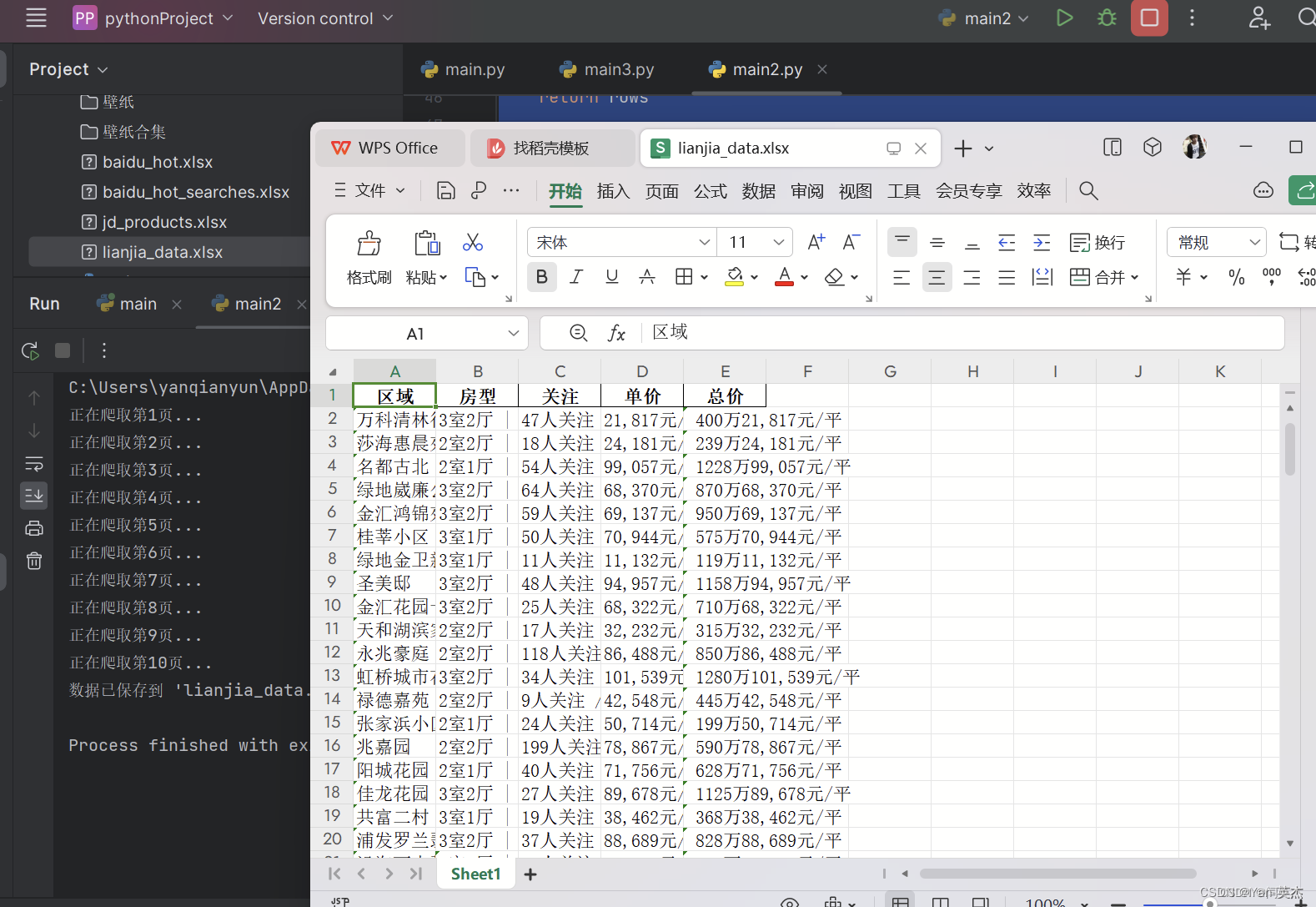
代码思路:
首先,我们定义了一个函数 fetch_data(page_number),用于获取指定页面的房屋信息数据。这个函数会构建对应页数的 URL,并发送 GET 请求获取页面内容。然后,使用 BeautifulSoup 解析页面内容,并提取每个房屋信息的相关数据,如区域、房型、关注人数、单价和总价。最终将提取的数据以字典形式存储在列表中,并返回该列表。
接下来,我们定义了主函数 main(),该函数控制整个爬取和保存数据的流程。在主函数中,我们循环爬取前 10 页的数据,调用 fetch_data(page_number) 函数获取每一页的数据,并将数据追加到列表中。然后,将所有爬取的数据存储在 DataFrame 中,并使用 df.to_excel('lianjia_data.xlsx', index=False) 将数据保存到 Excel 文件中。
最后,在程序的入口处,通过 if __name__ == "__main__": 来执行主函数 main()。
源代码:
import requests from bs4 import BeautifulSoup import pandas as pd # 收集单页数据 xpanx.com def fetch_data(page_number): url = f"https://sh.lianjia.com/ershoufang/pg{page_number}/" response = requests.get(url) if response.status_code != 200: print("请求失败") return [] soup = BeautifulSoup(response.text, 'html.parser') rows = [] for house_info in soup.find_all("li", {"class": "clear LOGVIEWDATA LOGCLICKDATA"}): row = {} # 使用您提供的类名来获取数据 xpanx.com row['区域'] = house_info.find("div", {"class": "positionInfo"}).get_text() if house_info.find("div", { "class": "positionInfo"}) else None row['房型'] = house_info.find("div", {"class": "houseInfo"}).get_text() if house_info.find("div", { "class": "houseInfo"}) else None row['关注'] = house_info.find("div", {"class": "followInfo"}).get_text() if house_info.find("div", { "class": "followInfo"}) else None row['单价'] = house_info.find("div", {"class": "unitPrice"}).get_text() if house_info.find("div", { "class": "unitPrice"}) else None row['总价'] = house_info.find("div", {"class": "priceInfo"}).get_text() if house_info.find("div", { "class": "priceInfo"}) else None rows.append(row) return rows # 主函数 def main(): all_data = [] for i in range(1, 11): # 爬取前10页数据作为示例 print(f"正在爬取第{i}页...") all_data += fetch_data(i) # 保存数据到Excel xpanx.com df = pd.DataFrame(all_data) df.to_excel('lianjia_data.xlsx', index=False) print("数据已保存到 'lianjia_data.xlsx'") if __name__ == "__main__": main()六、爬取豆瓣电影排行榜TOP250存储到CSV文件中
代码思路:
首先,我们导入了需要用到的三个Python模块:requests、lxml和csv。
然后,我们定义了豆瓣电影TOP250页面的URL地址,并使用getSource(url)函数获取网页源码。
接着,我们定义了一个getEveryItem(source)函数,它使用XPath表达式从HTML源码中提取出每部电影的标题、URL、评分和引言,并将这些信息存储到一个字典中,最后将所有电影的字典存储到一个列表中并返回。
然后,我们定义了一个writeData(movieList)函数,它使用csv库的DictWriter类创建一个CSV写入对象,然后将电影信息列表逐行写入CSV文件。
最后,在if __name__ == '__main__'语句块中,我们定义了一个空的电影信息列表movieList,然后循环遍历前10页豆瓣电影TOP250页面,分别抓取每一页的网页源码,并使用getEveryItem()函数解析出电影信息并存储到movieList中,最后使用writeData()函数将电影信息写入CSV文件。
效果图:
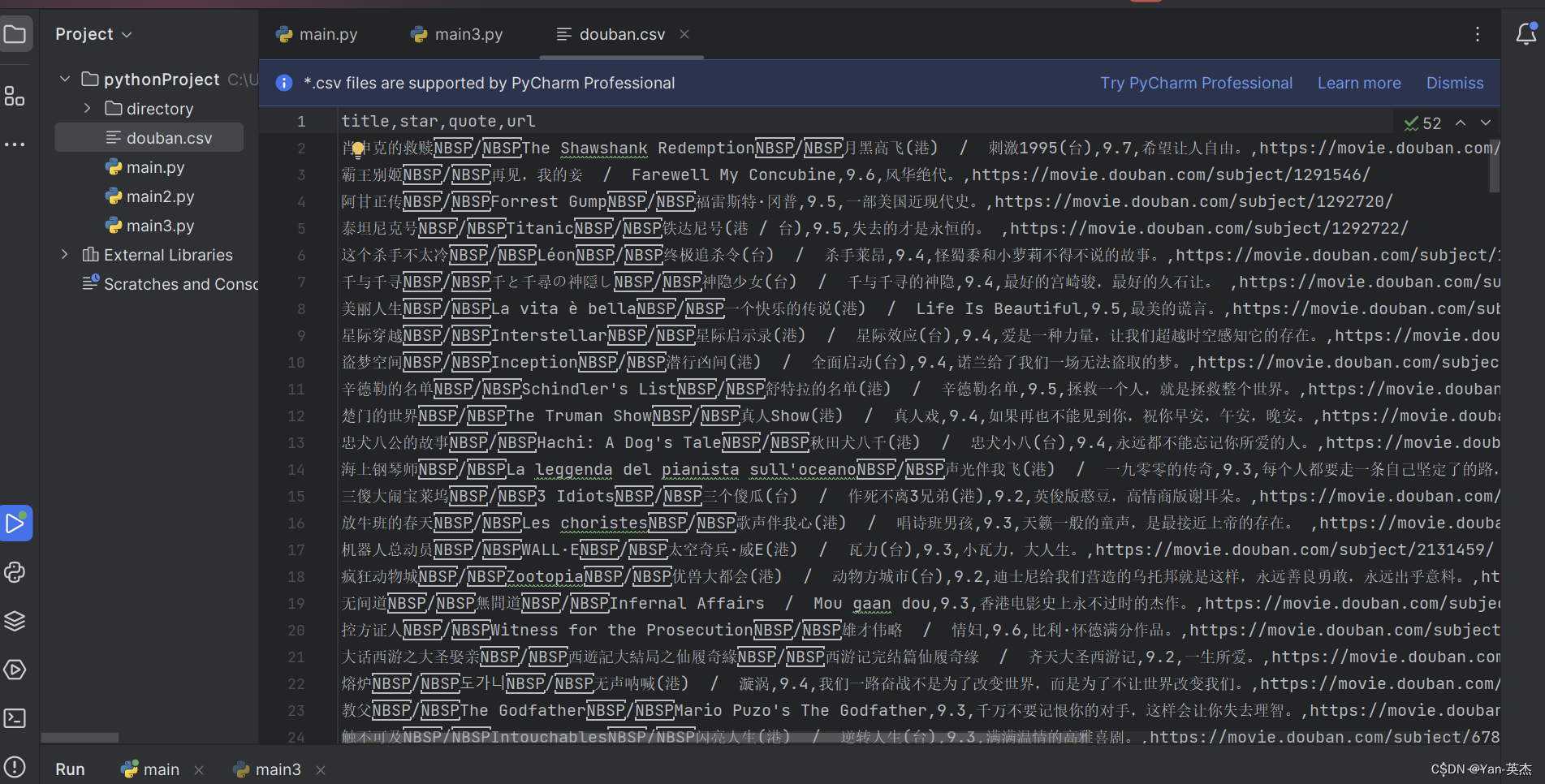
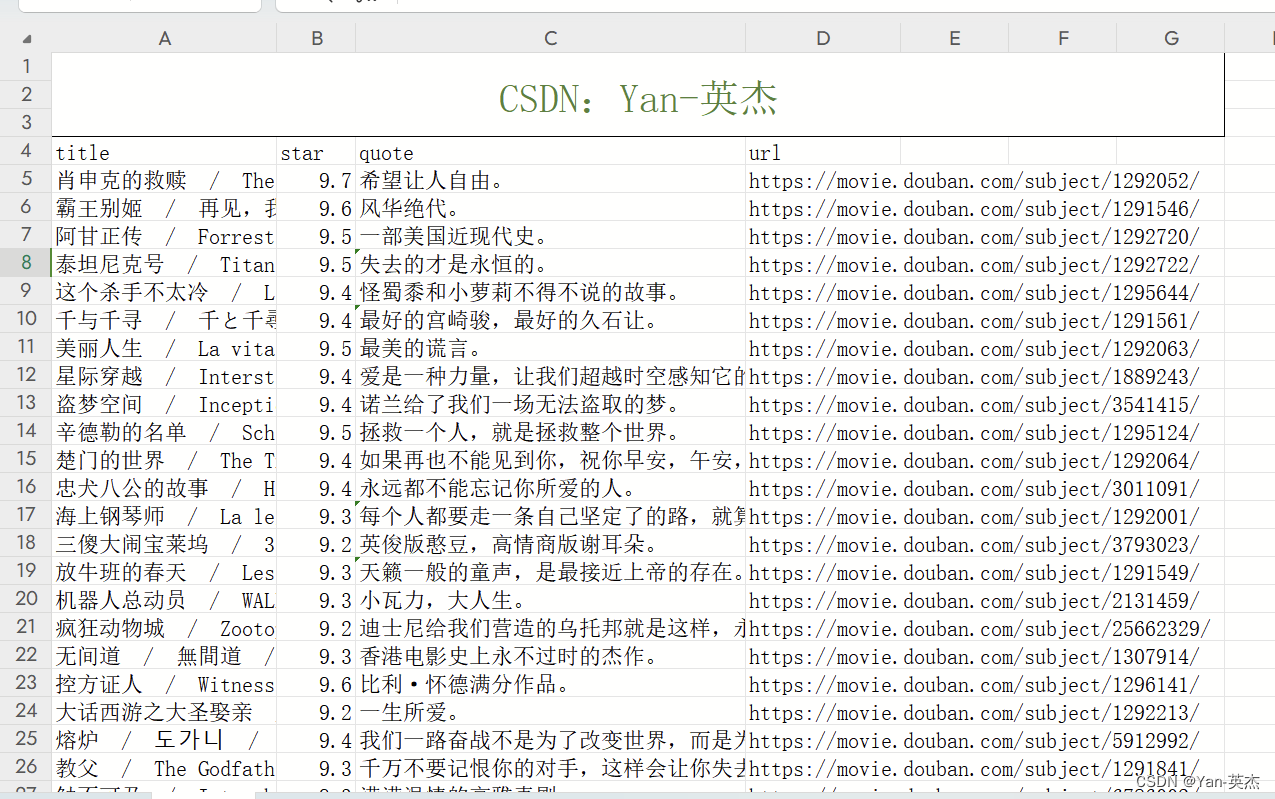
源代码:
私信博主进入交流群,一起学习探讨,如果对CSDN周边以及有偿返现活动感兴趣: 可添加博主:Yan--yingjie 如果想免费获取图书,也可添加博主微信,每周免费送数十本 #代码首先导入了需要使用的模块:requests、lxml和csv。 import requests from lxml import etree import csv # doubanUrl = 'https://movie.douban.com/top250?start={}&filter=' # 然后定义了豆瓣电影TOP250页面的URL地址,并实现了一个函数getSource(url)来获取网页的源码。该函数发送HTTP请求,添加了请求头信息以防止被网站识别为爬虫,并通过requests.get()方法获取网页源码。 def getSource(url): # 反爬 填写headers请求头 headers = { 'User-Agent': 'Mozilla/5.0 (Windows NT 10.0; Win64; x64) AppleWebKit/537.36 (KHTML, like Gecko) Chrome/79.0.3945.88 Safari/537.36' } response = requests.get(url, headers=headers) # 防止出现乱码 response.encoding = 'utf-8' # print(response.text) return response.text # 定义了一个函数getEveryItem(source)来解析每个电影的信息。首先,使用lxml库的etree模块将源码转换为HTML元素对象。然后,使用XPath表达式定位到包含电影信息的每个HTML元素。通过对每个元素进行XPath查询,提取出电影的标题、副标题、URL、评分和引言等信息。最后,将这些信息存储在一个字典中,并将所有电影的字典存储在一个列表中。 def getEveryItem(source): html_element = etree.HTML(source) movieItemList = html_element.xpath('//div[@class="info"]') # 定义一个空的列表 movieList = [] for eachMoive in movieItemList: # 创建一个字典 像列表中存储数据[{电影一},{电影二}......] movieDict = {} title = eachMoive.xpath('div[@class="hd"]/a/span[@class="title"]/text()') # 标题 otherTitle = eachMoive.xpath('div[@class="hd"]/a/span[@class="other"]/text()') # 副标题 link = eachMoive.xpath('div[@class="hd"]/a/@href')[0] # url star = eachMoive.xpath('div[@class="bd"]/div[@class="star"]/span[@class="rating_num"]/text()')[0] # 评分 quote = eachMoive.xpath('div[@class="bd"]/p[@class="quote"]/span/text()') # 引言(名句) if quote: quote = quote[0] else: quote = '' # 保存数据 movieDict['title'] = ''.join(title + otherTitle) movieDict['url'] = link movieDict['star'] = star movieDict['quote'] = quote movieList.append(movieDict) print(movieList) return movieList # 保存数据 def writeData(movieList): with open('douban.csv', 'w', encoding='utf-8', newline='') as f: writer = csv.DictWriter(f, fieldnames=['title', 'star', 'quote', 'url']) writer.writeheader() # 写入表头 for each in movieList: writer.writerow(each) if __name__ == '__main__': movieList = [] # 一共有10页 for i in range(10): pageLink = doubanUrl.format(i * 25) source = getSource(pageLink) movieList += getEveryItem(source) writeData(movieList)